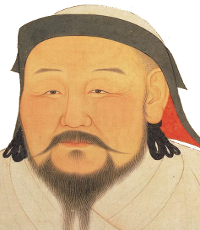Genghis Khan in today’s Mongolia
During the communist period, 1924-1992, when the Soviet Union exercised a strong influence in the country, textbooks used in Mongolian schools described Genghis Khan as a “reactionary” and an “enemy of the people.” However, in commemoration of the 800th anniversary of his birth in 1962, a monument was erected in his honor and an academic conference was held to discuss his life and legacy. The conference ended with applause, cheers and chants for Genghis Khan. Agents for the KGB, the Soviet secret service, who were present on the occasion, reported the event to Moscow. The result was purges within the leadership of the Mongolian Communist Party. Those who had sided with Genghis Khan were regarded as enemies of the Soviet Union.
Since the end of communism, there has been a strong revival of interest in Genghis Khan in Mongolia and he is now regarded as a national hero. Mongolians are quick to insist that his reputation as a bloodthirsty barbarian is vastly exaggerated. In 2008, Genco Tour Bureau, a private company, erected a 40 meter tall equestrian statue of him in stainless steel at the cost of 4.1 million US dollars. Entering the statue, visitors can take an elevator to the head of the horse on which Genghis is riding and enjoy a panoramic view of the Mongolian steppe.
In today’s Mongolia, Genghis’ name and likeness can be found on products ranging from liquor bottles and energy drinks to cigarette packages and candy, as well as on the bills people use to pay for these items. The Mongolian parliament has discussed the risk of trivializing Genghis’ memory but the discussions have not so far resulted in any legislation. From 2012, the first day of the first winter month of the year is designated as Genghis Khan’s birthday and a national holiday. His actual birthday is unknown. According to the customs of his tribe, Great Khan was buried in a grave without markings. It is said that 10,000 horses trampled the ground where he was buried, that a forest was planted over the site, or that a river was diverted to cover it. Not surprisingly perhaps the grave has never been located.
External links
- American Center for Mongolian Studies
- Estimate of the number of people killed by the Mongols
- François Pétis, The History of Genghizcan the Great, First Emperor of the Antient Moguls and Tartars, 1710
- Mongolia: A Country Study, 1991
- National Geographic, "Genghis Khan's Secret Weapon Was Rain"
- The Realm of the Mongols
- The Ulaanbaatar Post

